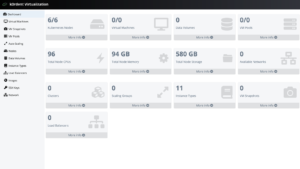Mirantis Extends Appeal of Control Plane to Traditional IT Administrators
Mirantis today extended the capabilities of an enterprise edition of an open source control plane to add workflow capabilities that are designed to be familiar to VMware administrators.
Since earlier this year, Mirantis has been making a case for a k0rdent control plane that can be used to declaratively manage containers and virtual machines running on any distribution of Kubernetes. In addition, Mirantis provides access to an enterprise edition of k0rdent that it supports on behalf of IT organizations.
Now Mirantis is adding a set of templates for managing workflows running on Kubernetes clusters that presents IT administrators using the commercial version of k0rdent with a graphical user interface (GUI) through which they can manage Kubernetes platforms.
Dominic Wilde, vice president of marketing for Mirantis, said that capability, in the wake of recent licensing changes to VMware software that have been instituted by Broadcom, is critical for IT teams looking to adopt Kubernetes platforms as an alternative. Most VMware administrators are not especially familiar with YAML files and Helm charts, so these templates will make it easier for them to transition to Kubernetes platforms, he added.
It’s not clear how many IT teams that are relying on VMware today are migrating to Kubernetes clusters, but the smaller organizations can migrate in a matter of weeks. Larger organizations, depending on their zeal, can migrate in a few months or, alternatively, slowly migrate over time based on whenever their VMware license is set to renew, noted Wilde.
Regardless of how long that effort may take, IT organizations eventually wind up reducing the total cost of IT by reducing the number of management frameworks that would be required to manage containers, virtual machines and Kubernetes clusters, he added.
Cloud service providers have been using control planes to manage IT environments at scale. K0rdent now makes it possible for internal IT teams to centrally manage Kubernetes environments similarly. At its core, a control plane provides a framework that determines how data is managed, routed and processed.
The challenge is that as Kubernetes clusters become more distributed to, for example, the network edge, the need to centrally manage those clusters at scale becomes a more pressing concern. One of the reasons many organizations initially embrace platform engineering as a methodology for managing DevOps workflows at scale is the need to manage large numbers of Kubernetes clusters.
That’s crucial because Kubernetes is increasingly becoming the default platform for deploying new applications that are mostly developed using containers. At the same time, Kubernetes continues to become steadily more accessible to IT administrators that now often work alongside DevOps and platform engineers to manage cloud-native application environments. The overall goal is to make it simpler to manage Kubernetes clusters in a way that reduces the level of expertise that’s historically been required.
Ultimately, it’s not so much a question of whether Kubernetes clusters will be deployed in production environments as much as it is to what degree based on the amount of internal expertise available to manage them. As the number of IT administrators that are familiar with Kubernetes increase, so too will the pace at which applications will be deployed on the platform.



